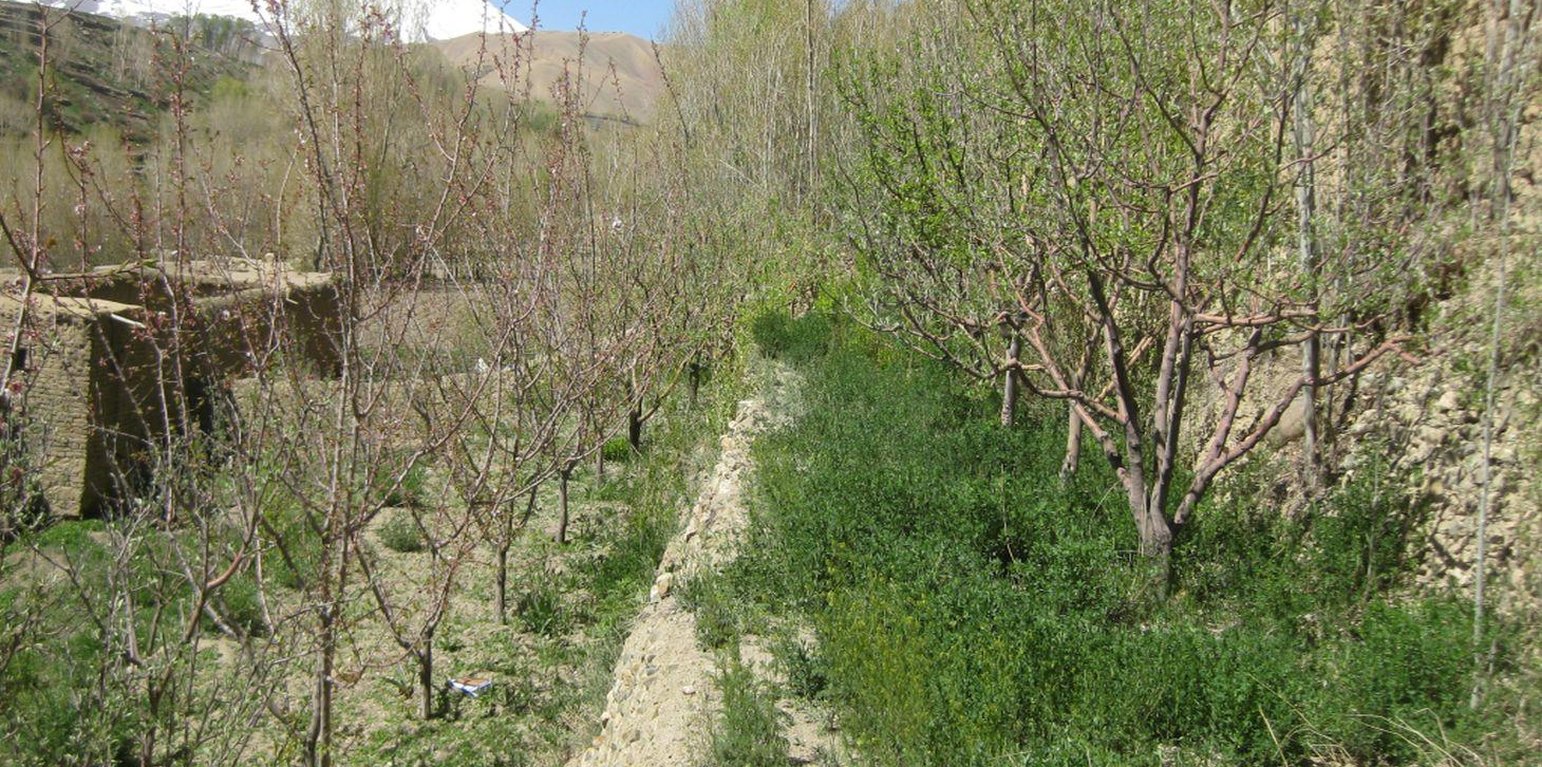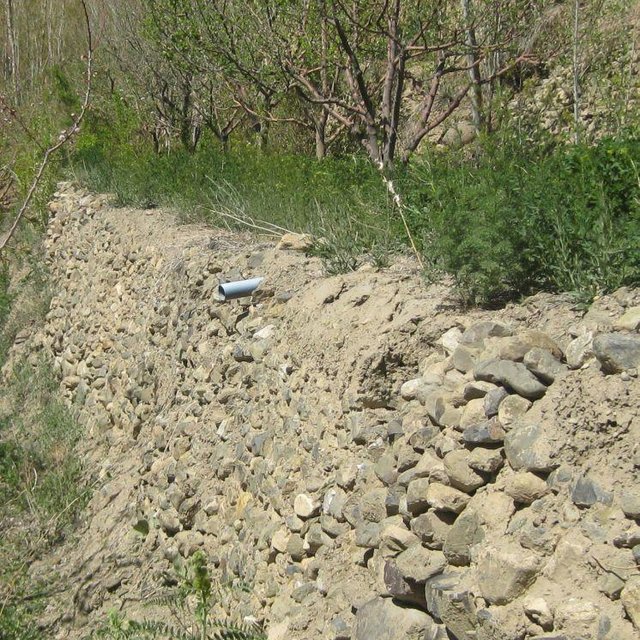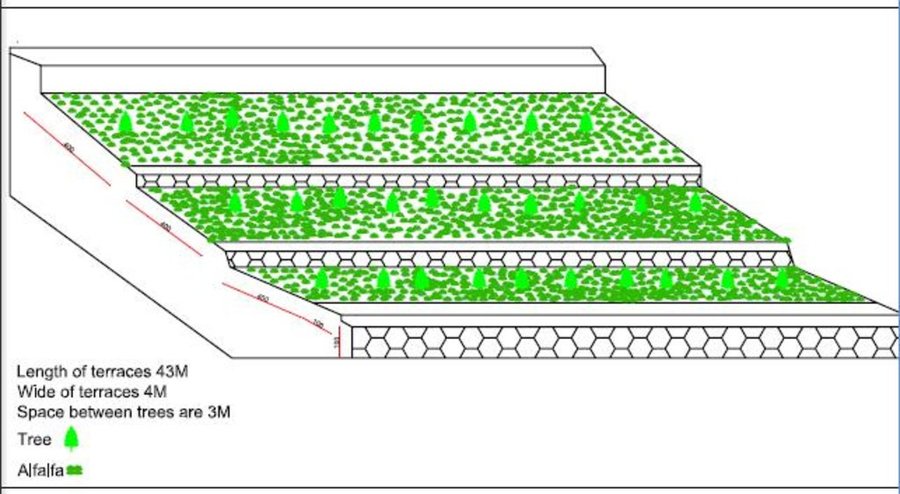



The Alfalfa inter-cropping in terraced fruit orchard technology is documented by Sustainable Land Management Project/HELVETAS Swiss Intercooperation with financial support of Swiss Agency for Development and Cooperation (SDC).
In the semi-arid regions of the Central Highlands in Afghanistan, land is intensively used for the
cultivation of subsistence (wheat) and cash crops. The technology presented here provides an economically sound solution for soil and water conservation. In this example, Alfalfa is grown in the spaces between the young trees to make use of the soil, light and water. The soil and water conservation quality of the technology is further enhanced with terracing to capture water.
Purpose of the Technology: The main purpose of establishing the fruit orchard with Alfalfa was to produce fruits for both
consumption and income, as well as for animal fodder. Terraces are important for retaining soil moisture, reducing soil erosion and preventing nutrient leaching. Alfalfa increases soil fertility as it fixes
nitrogen.
Establishment / maintenance activities and inputs: The area under this specific technology is less than 0.03 ha. The technology was established by the land user five years ago without external support. In the past, the site was sloping agriculture land used for potato and wheat cultivation, the two major staple crops in Bamyan. Animal manure, with small quantities of chemical fertilizers, were used to maintain the soil fertility. The farmer, Haji Hussain, learning from similar examples from Kabul, applied this technology on his private land
with sight modifications by including terraces for soil and water conservation. For the construction of one terrace, 14 person days are needed. The size of one terrace was about 43 m in length and 4 m in width.Initially the terraces were used for vegetable cultivation. Later on, he planted mainly apple and apricot trees and a few saplings of pear and plum. Two varieties of apple (red and yellow) were planted in the orchard and the distance between two trees in a row was about 3 m (for more details, please see the technical drawing). The saplings were prepared by the farmer himself using grafting. The trees vary in age, from 3-5 years. Alfalfa was planted 1-3 years ago. The farmer applies 1 kg urea and DAP per tree every spring in addition to a small quantities of manure. The orchard requires irrigation almost every week from mid-spring to autumn from a nearby canal. The water distribution and operation and maintenance of the irrigation infrastructure is regulated by a Mirab, or “Water Master”, elected by the water users and farmers.
Natural / human environment: Bamyan Center has temperate and semi-arid climate with an average annual rainfall of about 230 mm. The area receives snow during the winter season and the temperature can drop below -20 degree centigrade.There is one growing season from April to September. The soil in the orchard is sandy loam with moderate soil fertility. Orchards are considered to be more profitable by the land user than growing crops like wheat and potato. Before applying this technology, the average annual income of the owner from 0.3 ha land was 9,000 Afghani, equivalent to approx 180 USD. While after the application of terraced orchard with Alfalfa cultivation technology, his average annual income from 0.3 ha increased to 45000 Afghani or 900 USD.
Location: Bamyan Centre / Shinya Fuladi, Bamyan, Afghanistan
No. of Technology sites analysed: single site
Spread of the Technology: evenly spread over an area (0.0003 km²)
In a permanently protected area?:
Date of implementation: 10-50 years ago
Type of introduction







| Specify input | Unit | Quantity | Costs per Unit (Afghani) | Total costs per input (Afghani) | % of costs borne by land users |
| Labour | |||||
| Construction of terraces | persons/day/ha | 400.0 | 400.0 | 160000.0 | 100.0 |
| Plant material | |||||
| Plantation of saplings | pieces/ha | 800.0 | 150.0 | 120000.0 | 100.0 |
| Plantation of alfalfa | kg/ha | 100.0 | 250.0 | 25000.0 | 100.0 |
| Total costs for establishment of the Technology | 305'000.0 | ||||
| Total costs for establishment of the Technology in USD | 5'350.88 | ||||
| Specify input | Unit | Quantity | Costs per Unit (Afghani) | Total costs per input (Afghani) | % of costs borne by land users |
| Fertilizers and biocides | |||||
| Fertilizer application only | kg/ha | 800.0 | 16.0 | 12800.0 | 100.0 |
| Total costs for maintenance of the Technology | 12'800.0 | ||||
| Total costs for maintenance of the Technology in USD | 224.56 | ||||
Quantity before SLM: 0
Quantity after SLM: 420 kg
Fruit production
Alfalfa
Alfalfa
Due to alfalfa consumption
Pruned twigs can be used for firewood
Quantity before SLM: 10,000 Afghani
Quantity after SLM: 45,000 Afghani
Due to more income and production
Due to greenery and sound of birds.
Farmer to farmer knowledge exchange
The technology help in increased income which can be used for buying food. Families consume more and a greater variety of foods which is beneficial for health.
More species, cultivated and natural
E.g. Birds